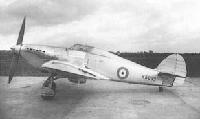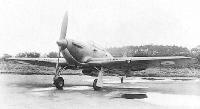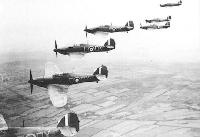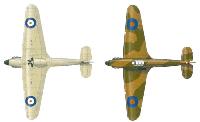Фотографии
-
Регистрационный номер: L1679 Hawker Hurricane I L1679 'JX-G' of 1 Squadron, Vassincourt, France, flown by Fg Off Paul Richey, in early 1940. Dark Green/Dark Earth to ‘A’ pattern, undersurfaces divided on the centre-line, Black port and White starboard. A 25in A-type fuselage roundel and 45in A-type underwing, specified in September 1939, for all aircraft flying over France. The 49in upper wing roundel, appears to be a partially modified A1-type, retaining approximately lin of the yellow outer ring. Code letters in Medium Sea Grey, approximately 30in high. Spinner tip could be red.
Самолёты на фотографии: Hawker Hurricane - Великобритания - 1935
-
Регистрационный номер: L1568 Hawker Hurricane I L1S68 ‘S' of 73 Squadron, Digby, 1938. Dark Green/Dark Earth to 'B'pattern, with Aluminium undersurfaces and 30in (76.2cm) underwing serials. A 35in A1-type fuselage, 49in B-type upperwing roundels and 45in A-type underwing. Fuselage serial 6in high. White 'Arrowhead' on fin with squadron insignia. Code letters in Medium Sea Grey, approximately 24in on fuselage and 21in on fin.
Самолёты на фотографии: Hawker Hurricane - Великобритания - 1935
-
Регистрационный номер: L1774 Hawker Hurricane I L1774 'LK-D' of 87 Squadron, Lille/Seclin, March 1940. Dark Green/Dark Earth to 'B'pattern, undersurfaces divided on the centre-line, Black port and White starboard. A 35in A-type fuselage roundel, 49in B-type upperwing, and 45in A-type underwing, specified in September 1939, for all aircraft flying over France. Code letters in Medium Sea Grey, approximately 35in high.
Самолёты на фотографии: Hawker Hurricane - Великобритания - 1935
-
Регистрационный номер: P3878 Hawker Hurricane I P3878 'YB-W' of 17 Squadron, Debden, in July 1940. Flown by Fg Off H A C Bird-Wilson. Typical Battle of Britain finish post-June 1940, except for the Sky spinner in place of the authorised Black. Dark Green/Dark Earth to 'B' pattern, with Sky undersurfaces. A 35in Al fuselage and 49in B-type upperwing roundels. Codes approx 40in high in Medium Sea Grey.
Самолёты на фотографии: Hawker Hurricane - Великобритания - 1935
-
Регистрационный номер: V6935 Hawker Hurricane I V6935 'DU-W' of 312 (Czech) Squadron, Speke, Aug/Sept 1940. Dark Green/Dark Earth to ‘B’ pattern, with Sky undersurfaces and Black spinner. A 35in A1-type fuselage, 49in B-type upperwing and 49in A-type underwing. Fin flash 27 x 24in. 30in Medium Sea Grey codes. The 'standard' post early-August 1940, Battle of Britain finish.
Самолёты на фотографии: Hawker Hurricane - Великобритания - 1935
-
Регистрационный номер: L11940 Hawker Hurricane I L1940 'OP-R' of 3 Squadron, Kenley, in the summer of 1939. Dark Green/Dark Earth to 'B' pattern, undersurfaces divided on the centre-line, Black port and White starboard. A 25in B-type fuselage and 35in B-type upperwing roundels, converted from 35in and 49in Al roundels respectively. Underwing roundels are 49in A-type, possibly overpainted on the port side, while the 30in serial was probably still present, as evidenced by adjacent aircraft. Code letters Medium Sea Grey, approximately 35in high.
Самолёты на фотографии: Hawker Hurricane - Великобритания - 1935
-
Регистрационный номер: G-HUPW, R4118 Peter Vacher's superb Battle of Britain veteran Hurricane I R4118 (G-HUPW) has been flying since December 2004.
Самолёты на фотографии: Hawker Hurricane - Великобритания - 1935
-
Регистрационный номер: P3351, TB863, ZK-TPL, ZK-XVI, G-CDAN Stuart Goldspink flying the Alpine Fighter Collection’s Hurricane II P3351 (ZK-TPL) near Wanaka, New Zealand, in April 2006. Alongside is AFC's Spitfire XVI TB863 (ZK-XVI), flown by Nigel Lamb. ZK-TPL was built as a Mk.I
Самолёты на фотографии: Hawker Hurricane - Великобритания - 1935Supermarine Spitfire Mk.IX / XVI - Великобритания - 1942
-
Unusual (and helpful) view of Hurricane Is of 56 Squadron - note the lack of overwing roundels. No. 56 Squadron took on Mk.ls from May 1938 when they were based at North Weald, Essex. From September 1938 they carried the code-letters 'LR-', adopting 'US-' from September 1939. The unit moved to Martlesham Heath, Suffolk, in October 1939. All of this helps to 'place' the photo as having been taken at North Weald. The last digit of the serial, L160x' of 'O-for-Orange' is frustratingly unreadable. This is so because, with the exception of L1604 and L1606, all of the Hurricanes with serial beginning L160x' were delivered from new to No.561
Самолёты на фотографии: Hawker Hurricane - Великобритания - 1935
-
Регистрационный номер: L1767 Uncoded Mk.Is of 151 Squadron, probably at North Weald, Essex, where the unit had been based since April 1939. No.151 re-equipped with Hurricanes from December 1938, when the code-letters 'GG-' were allocated to them, before settling upon 'DZ-' from September 1939. L1767 (foreground) was written off on April 14, 1939, when it undershot on landing at North Weald at night
Самолёты на фотографии: Hawker Hurricane - Великобритания - 1935
-
Регистрационный номер: N2479 Hurricane I N2479 was delivered from new to 56 Squadron at North Weald, Essex, in January 1940, taking on 'US-' codes. (By the look of it, either 'B', 'P' or 'R' was the individual letter.) N2479 went on to serve with 213 Squadron and 6 Operational Training Unit before being converted to a Mk.IIA with the new serial number BV168 in 1941. It served on until destroyed in a collision with a Consolidated Liberator II AL540 at Lydda, Palestine, on November 18,1943
Самолёты на фотографии: Hawker Hurricane - Великобритания - 1935
-
Регистрационный номер: P3428 Going by the white flying helmet worn by the pilot, this is a pre-delivery view of Mk.I P3428. Built at Brooklands in early 1940, it was delivered to 245 Squadron and would have gained a 'DX-' code. It was destroyed in a fatal accident on June 26, 1941, when it hit cables while flying low near Ballymena, Northern Ireland.
Самолёты на фотографии: Hawker Hurricane - Великобритания - 1935
-
Регистрационный номер: K5083 The prototype Hurricane, K5083, at Brooklands. It is fitted with the intermediate canopy, has the struts for the tail surfaces and carries no radio mast.
Самолёты на фотографии: Hawker Hurricane - Великобритания - 1935
-
A wheel change and the application of unit codes being carried out in September 1939. Almost certainly at Debden, Essex, a Mk.I is seen receiving the 17 Squadron code letters 'UV-' and a wheel change. From 1940, the luxury of trestles was not available to 'erks'. No. 17 operated Mk.Is from June 1939 to February 1941
Самолёты на фотографии: Hawker Hurricane - Великобритания - 1935
-
Регистрационный номер: L1547 The first production Hurricane I L1547 at Brooklands in late 1937. After trials with Hawker and at the Aeroplane & Armament Experimental Establishment, it was issued to 312 (Czechoslovakian) Squadron at Speke, Lancashire. On October 10, 1940, a fire broke out whilst airborne and it plunged into the River Mersey off Ellesmere Port. Sgt O Hanzlicek bailed out, but was killed.
Самолёты на фотографии: Hawker Hurricane - Великобритания - 1935
-
Регистрационный номер: P3408 Mk.I P3408 almost certainly in service with 85 Squadron, in which case the unit code letters would be 'VY-'. No.85 began operating Hurricanes from September 1938 from Debden, Essex, before joining the British Expeditionary Force in 1940. Delivered from new to 85, P3408 went on to serve with no less than another ten units, before being struck off charge in July 1944.
Самолёты на фотографии: Hawker Hurricane - Великобритания - 1935
-
Регистрационный номер: P3101 Hurricane Is of 245 Squadron, the photo being dated November 19, 1940. During the entire time that 245 flew Mk.Is - March 1940 to August 1941 - its aircraft carried the codes 'DX-'. No.245 was based at Aldergrove, Northern Ireland, from July 1940 to July 1941. The aircraft extreme bottom left is P3101 that was delivered to 245 from new in 1940. Just visible below the cockpit is a diamond-shaped badge, but what is the individual code? Can readers help?
Самолёты на фотографии: Hawker Hurricane - Великобритания - 1935
-
Регистрационный номер: P2647 Mk.I P2647 of 73 Squadron after suffering a nose-over. No.73 was at Digby, Lincs, when it took delivery of its brand-new Mk.Is from July 1938. The Hurricane survived this incident, going on to serve with 1 Sqn RCAF, 213 Squadron and finally 52 Operational Training Unit, being struck off charge in December 1941. The different style of the unit codes ('TP-' - allocated in September 1939) and the individual letter ('X') are noteworthy
Самолёты на фотографии: Hawker Hurricane - Великобритания - 1935
-
Top and bottom view of L1940 showing 'typical' 1939 finish. 'A' pattern uppersurfaces and equal black/white divide on undersurfaces.
Самолёты на фотографии: Hawker Hurricane - Великобритания - 1935
-
Top and bottom view of V6935, showing 'typical' post early-August 1940, Battle of Britain finish. Dark Green/Dark Earth to ‘B’ pattern, with Sky undersurfaces.
Самолёты на фотографии: Hawker Hurricane - Великобритания - 1935
Статьи
- Round-Out
- The Roundels File
- A.Ord-Hume - Folland's Civil Side /Paper planes/
- A.Thomas - Light Blue Fishes /World war two/
- D.Willis - First Time Around /Prototypes and experimentals/
- D.Willis - V for Variety /Air forces/ (3)
- K.Wilson - Taking a Hit /Post-war combat/
- K.Wilson - Wings of Liberty /History on the wing/
- M.Huggins - Sea Eagle Rising /World war two/
- R.Lindholm, S.Stridsberg - Nordic Lance /Post-war combat/
- S.Grivno - Last Flight of 'Zebra 442' /World war two/



















